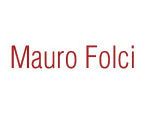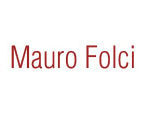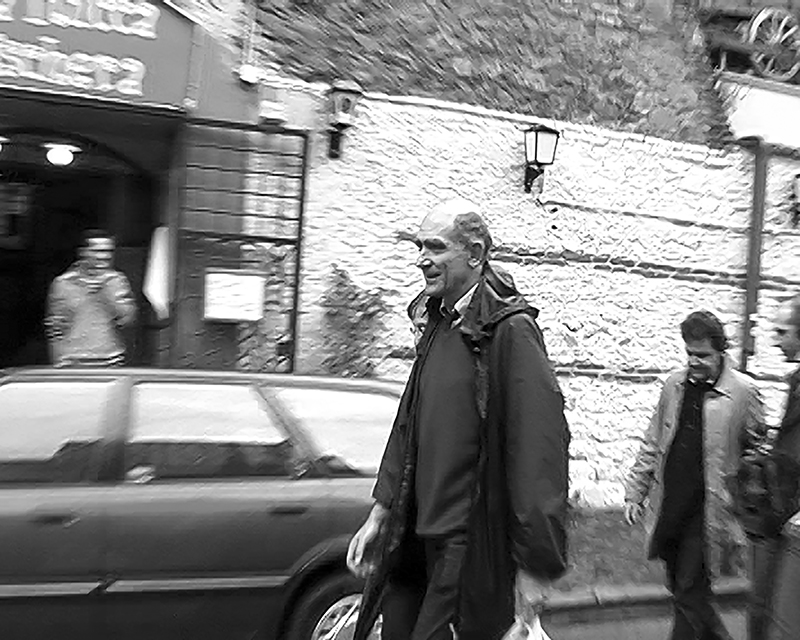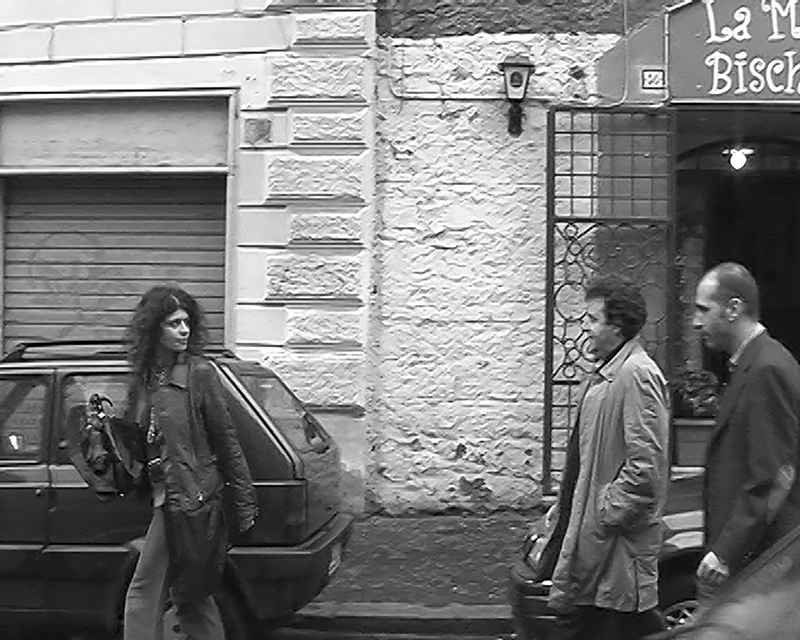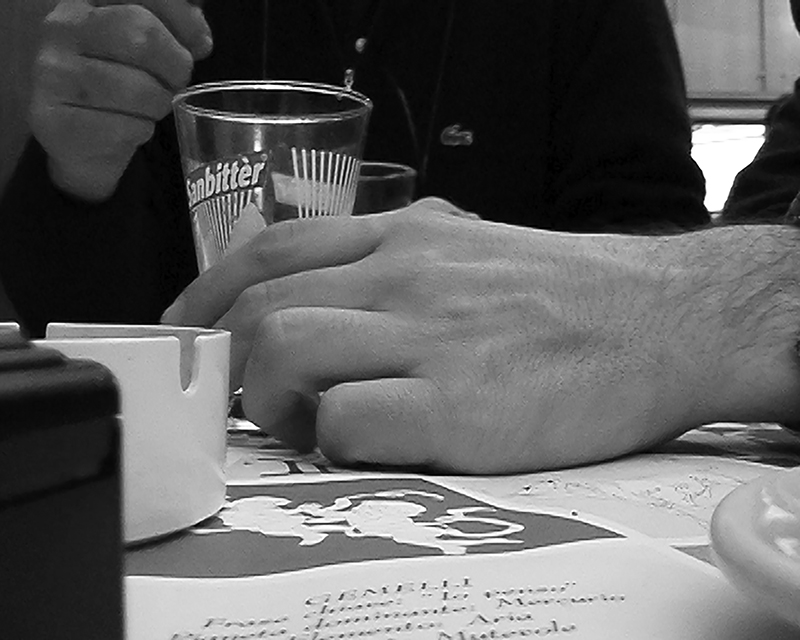Read the whole article
Meta-chat
Mauro Folci’s performance CHAT (2004) was planned to take place at a bar in the historic San Lorenzo neighbourhood in Rome. With an expected audience limited to the occasional customers that might have been there at the time, the performance consisted of a simple chat between the artist, journalist Raffaella de Santis, philosopher Paolo Virno, sociologist Tito Marci, artists Alberto Zanazzo and Mauro Folci. The conversation, revolving around chatter in contemporary society, a topic set by Folci, can be defined a meta-chat: chatting about the very act of chatting, whose aim is to individuate the rules and the structures that underlie chatter.
It is an interesting performance in so far as it took shape at a time of crisis in Folci’s artistic production. The artist decided to focus his work on the feeling of crisis and failure which seemed to affect his art after his previous performance, THE AGREEABLE JUST IN TIME, reached a crucial point in his reflection on the process of identification of language and work. The hole in the ground dug at the Foundation Barichello for the THE AGREEABLE JUST IN TIME, about the Fiat production plant in Melfi and the ‘just in time’ work practices, created a laceration that might have led the artist to complete inaction. Once posited the coincidence between work and language, this recession becomes implicit. If we are working whilst talking, and talking whilst working, and if art is a form of work that is grappling with language, we need to rethink its very status, its social value and even the very possibility of being able to talk about art. Folci insists on the equation language-work and tries to describe it with another formula. According to him, we need to reflect on the issue of the fetishism of commodities, which coincides with the linguistic community nowadays. He discusses it in Soffio:
Already in the 1960’s linguistic philosopher Ferruccio Rossi Landi posited a stringent homology between material and immaterial production, in which the linguistic community figured as an immense market where words, expressions and messages circulate like commodities. For the Swiss economist, the sphere of communication was sucked into the sphere of instrumental action. Material and immaterial interact within an integrated system where linguistic work is in charge of producing and spreading communities, but only insofar as the system produces value by means of a community: the speaking commodity is put to work in order for it to reproduce itself through dreams, desires and images.
To conclude, I would like to offer some thoughts on the fetishism of commodities: if this is, according to Marx’s classical definition, the consequence of a mystification, i.e. the result of the concealment of the real relations engendered production within commodities; and if nowadays goods and services are produced by means of language, which is the faculty that distinguishes the human species, could it mean, perhaps, that it is the speakers’ community itself that takes on the characteristics of a fetish?
CHAT was simultaneously the anamnesis, the diagnosis, the prognosis and finally the treatment of the stalemate induced in the artist by AGREEABLE JUST IN TIME. It was an anamnesis in the sense that the artist expounded to his interlocutors the problem that was leading him to paralysis. Diagnosis as these thoughts were reduced to the category of chatter, as this is the most popular communicative mode in the linguistic community. Prognosis as the various interlocutors offered, with their contributions, possible routes of escape from the artist’s impasse. Finally, it was akin to therapy as it put into perspective the problem experienced by the artist, who continues to operate within the uncomfortable confines of reflection on language.
Rather than present a full transcription of the participants’ contributions, we shall quote those more relevant to the issues discussed above.
This performance was recorded and transcribed. The recordings bear witness to the entirely fortuitous character of intuitions and the rhythm that informs the mind, interrupted sentences and mumblings, breathing and cough, hesitation and aggressiveness, attempts at mediation, background noises, banalities and innermost convictions. All of these elements make chatter a type of discourse that demonstrates the generalities which language can express, its closeness to the impersonal dimension of ‘they say’. Chatter is the most typical form of expression of a pre-individual subjectivity, of a general ‘us’: the yet unidentified character of human beings. Chatter and oral dialogue are diametrically opposed to writing, in which reasoning is stripped of all dross and of all attempts to emerge from the obscurity of the mind. In this CHAT we find the bare moments of silence, truncated sentences, suspended thoughts. At times the interlocutor’s arguments remain open as they are re-codified by the others, other times the conversation takes new directions following unintentional rules. Usually unreflective, the thought characterizing chatter repeats previously formed reflections and commonplaces, but as Deleuze and Bateson have shown, it is precisely through different repetitions that novelty can emerge. Paradoxically, only the repetition of commonplaces triggers an unchecked process and creates the unexpected, perhaps even what has not been conjured up in thought.
Something unexpected must have emerged from the conversation if we think of the therapeutic effect it has had on the artist. The unexpected, as much as the expected, that chatter engenders was the focus of Raffaella de Santis’ contribution: We don’t chat because we want to get to a point. We can chat just for the sake of it…as a matter of fact we chat, we are unfocussed, we chirp. I am also thinking of literature, chatting is like going round in circles…But it can be an interesting thing if it is a way to escape pragmatic sense and time…that’s going round in circles, and at some point there could be an involuntary connection…we could find ourselves in a sphere of meaning which we hadn’t anticipated…So at that point chatter may become meaningful…and it is also reassuring for the person who is chatting. Because by chatting we protect ourselves in some way, don’t we? Even when we are not saying anything…I mean we protect ourselves simply because we recognize someone…but what could also happen…I was thinking that we might chat because we are afraid of something…for example when chatter takes hold of us, leads us by the hand, it starts as a recognition and then we may find ourselves in places we had not foreseen…perhaps that is the point in which it may turn into something else which, I believe, takes on a significance that goes beyond reassurance…
Tito Marci, with his focus on the transformation of art into a conceptual and argumentative discipline impresses a particularly interesting slant on the discussion, and wonders:
Why has chatter been undermined? I mean we find ourselves talking about chatter in some way because you want to bring it back to a level of discourse. That is the paradox isn’t it? That is, that chatter, starting from a scientific discourse…from Greece, has been undermined and turned into Doxa. It turns into all forms that…if we think about today’s communication theories, they always discount chatter, chatter is inessential with regards to scientific discourse…your starting point was the problem of art and of a stalemate and moment of crisis in your experience and also in general. But if you think about the problem in a different way …one of contemporary art’s problems is that it responds, in a radical sense, to the primacy of a scientific approach, because art becomes argumentation, it becomes argumentative. When the ideological supremacy of art is revelation and representation, it does not need to argue. In the supremacy of scientific logic, which is argumentative logic, and thus solves the problem of communication on argumentation, art too necessarily responds to this supremacy…You cannot legitimize the work of art but through argumentation, which could be the title or anything, but must always be connected to an essential supremacy which is the one of scientific logic, argumentative, procedural and so on…Thus removing chatter from common sense, or restoring to it a common sense removed from what you define the logic of capital gain and so on, doesn’t it amount to subjecting it to the supremacy of a scientific argument and to the supremacy of capitalist logic? This is the paradox I put to you…or else we have to find cracks in these conditions…
Carla Subrizi points out chatter’s relational function:
All of us come across people chatting at the market, and in their exchanges achieving meaning does not seem as useful as establishing a tie, a relationship characterized by ‘I am here’. If I manage to talk to you for ten minutes, I have established a contact that satisfies me from a relational point of view…I am not sure how significant it is whether we communicate something or not…so it’s neither a high or low level, as this happens at high levels too…now, for example…where I work, at the University, we hear chatter more often than actual achievement of something. Even if the exchange is at a high level, where one boasts all of one’s knowledge or alleged knowledge, it’s nothing more than what the two people at the market told each other: ‘I saw what he was wearing on television etc.’. It’s the same isn’t it?
In chatter the importance of establishing and communicating our presence, talking to make ourselves visible is more explicitly prioritized with regards to the content of my utterances. Carla Subrizi quotes a particularly favoured position by language scholar Gregory Bateson, who studied the differences and similarities between human beings and preverbal mammals:
It is a foible to use a syntax and a system of categories suited to the discussion of things that can be manipulated, when in reality we are talking of structures and relationships. And yet, this is exactly what is happening in this room. I am here talking to you, whilst you are listening and gazing at me; I am trying to persuade you, to show you things the way I see them, to win your respect, to show you mine, to arouse your interest and so on. What is happening in reality is a discussion on the structures underlying our relationship, and all this in conformity with the rules of a scientific convention on cetaceans. This is what being a human being means. […] Preverbal mammals communicate only when it is necessary, and essentially use signals on the structures of relationships. Vice versa, human beings use language, which is essentially oriented towards things, to discuss relationships. Cats ask for milk expressing their dependence, while I demand your attention and perhaps your respect by talking about cetaceans.(Bateson)
Among language forms, chatter reveals our essentially relational nature without the need to conceal itself in technical knowledge.
Paolo Virno echoes Subrizi’s position and underscores another aspect, chatter’s impersonal characteristics. We shall be concluding this section with a long quotation from the philosopher’s contribution, as it touches on another theme favoured by the artist, the remains in a work of art, a theme which will be fully explored in the last section of this text.
Virno reflects on the challenge to capitalist logic posed by several artistic practices, and how the very logic these opposed ultimately overwhelmed them. As a matter of fact, instrumental logic reappropriated their remains and turned them into commodities. This dialectic however is intrinsic to the public dimension of human actions. All action become public when it does not belong exclusively to an individual, as Alberto Zanazzo cogently explains in his contribution:
With the very fact that we belong to time, thus we are born, die and are imperfect beings…and, as Pasolini said when talking about language, about film, we, just by living, our presence in the landscape already constitutes an example…the example finishes when we die…and so belonging to time does not make us free, we play along with it and it’s a task in some sort…
Paolo Virno:
Chatter is…a fundamental form of language. I think there is a difference though between what Carla said about the ritual aspects of language, which distinguish us…An 18th century writer wrote: ‘speak so I can see you!’ As a human being, I see you when you break the silence…and chatter is a little different, because we can chat about very serious issues, we can chat about death…what is special about chatter is that it isn’t personal, it belongs to all and nobody at the same time…as a matter of fact defining it as a sort of…it’s not me or you, but it is a ‘yes’…this is what is extraordinary about language…the fact that we can talk about things we haven’t even experienced, so there is a function of language which is not denotative, which is manifest in chatter, otherwise what can you oppose to it? Authentic discussion? Then you are done for! If you fall into the whole authentic – inauthentic discussion…be my guest! That’s just one way, not the only way…but let us point out the advantages of chatter…because the fact that you’re under no obligation to describe things as they are, things as you have experienced, but you can let’s say…you can use a non referential language…that’s a repository from which you can invent…the two aspects – the ritual one of ‘speak so I can see you’ and chatter, which is a proliferation of discourses that don’t have to be anchored to a real experience – share some aspects…Since sometimes I can chat and talk about nothing to show myself to my interlocutor, to be recognised, but other times I can chat about extremely serious things which are known to everybody, which we have seen on TV, which we have read in the newspapers, concerning Iran, Iraq, the Fallujah massacre…I as one do not think it is a time devoted to superficial themes…I think that, if we keep with the classics, with Benjamin’s theories on technical reproducibility…it was an extraordinary eulogy of things very close to chatter…he said: here human ability of perception is enhanced. Of course this enhancement is the stake of the powers. It is exactly because it is enhanced that it becomes a productive force, the major social productive force. This human conversation…and then there is the issue of who leads it, who colonises it…but I don’t think that can be solved once and for all…that is, it is impossible to remove an artistic practice or pronouncement from the possibility of producing capital gain. The most revolutionary music of the 1960s and 70s originated in the black ghettos, and at some point things changed…but that is still part of the adventure of acting under other people’s gazes…of public action…that you don’t have any guarantees that your intention to break free might not in turn become a tool in your adversary’s hands…I am thinking about what the Situationists said, to look for forms of expression completely removed from mercification…an unfounded if ethically sharable idea…There is nothing to do, they can always catch us but that’s fine…like that common idea about politics ‘I don’t want to be exploited’…then don’t even leave home! No, I am there ready to be exploited! Possibly even running the risk that what is now a breach of conventions becomes an ingredient of capital gain. You can do something here and now whose destiny is not completely in your hands, but in many people’s who echo it and make it theirs…like the images of the Melfi plant that were taken from advertising material…that’s fine, that it could not be definitive. You pointed to a direction. We can take this direction or leave it. So much more so when modern art does not really produce an artwork, I mean an artwork with all of the emphasis of an artwork…does it? Whenever it does, it is closer to a performance, with its here and now…it relies on a reception like a gesture…a public gesture…
However Virno wonders what is the problem posed by this form of exploitation:
What is the problem? I think the problem is not so much that communication in the world of work is distorted and impoverished…yes,this may be an issue as well, but there are also situations which require…how can I say…a creative, expansive language…there is all sorts I think, the fact that this language put to work and the understanding of what is the hostile counter-party in this situation…when the body with its motor apparatus, its manual skills etc. was employed, our problem was to destroy the assemby lines, to break them to pieces as they were intolerable!! What is the hostile counter-party of this thing? This is the real problem of language put to work…We work thus we speak, we speak and thus we work…fine…what shall we do if the conflict is on this plane? This is the real problem…I think that the real hostile counter-party, the other side of the moon, the civil one as it reflects this situation…is in outdoing the shape taken by work itself…work has absorbed so many things that its very form is in some way too crowded…it explodes! There won’t be any work, work will become the stuff of memory just as slavery…we need to think up an activity that breaks away form the very dimension of work…
M.Roberti, by Working whilst talking. talking whilst working
Mauro Folci’s performance CHAT (2004) was planned to take place at a bar in the historic San Lorenzo neighbourhood in Rome. With an expected audience limited to the occasional customers that might have been there at the time, the performance consisted of a simple chat between the artist, journalist Raffaella de Santis, philosopher Paolo Virno, sociologist Tito Marci, artists Alberto Zanazzo and Mauro Folci. The conversation, revolving around chatter in contemporary society, a topic set by Folci, can be defined a meta-chat: chatting about the very act of chatting, whose aim is to individuate the rules and the structures that underlie chatter.[…]
